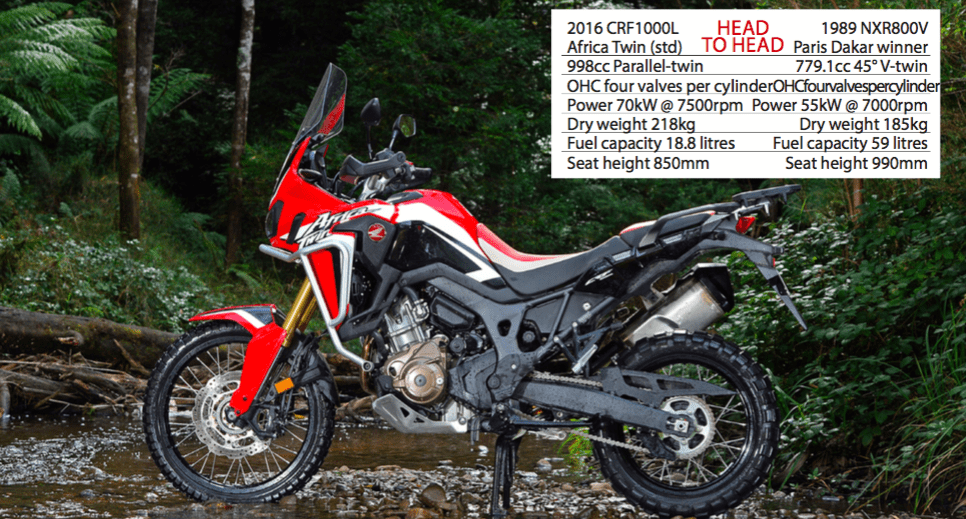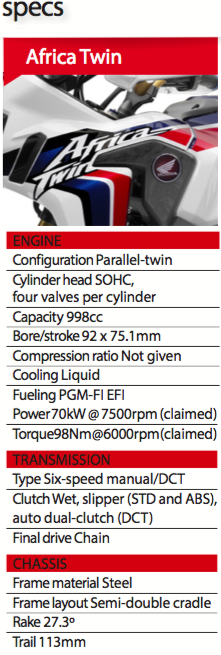Honda’s reborn Africa Twin has a lot to live up to and much more competition than the now legendary original ever had to fend off
The all-new CRF1000L Africa Twin was one of the most eagerly anticipated new models of 2016. This is partly due to the legendary status of the original Africa Twin, and partly down to the current popularity of adventure bikes. Considering how big this market has become, it seems remarkable Honda has been so slow to enter the fray. According to some sources, the CRF1000L project started back in 2009. If accurate, this amounts to a lengthy development period by industry standards – five years from concept to production is more usual. It seems that, despite the gaping hole in its model line- up, Honda was in no hurry to rush the Africa Twin to market. Fully formed prototypes, production ready in appearance, have been in the public eye for a couple of years. I guess when Honda’s head honchos decided to resurrect a legend, they knew they couldn’t leave anything to chance.
So, the question is, did they get it right?
From the very first inference of a new Africa Twin being in development my expectations have been high, and they were only elevated further when early images broke the internet.
These inflated expectations came from a combination of the Africa Twin name, and the photographic illusion of it looking like a compact and light, trail-shredding off-road focused adventure weapon. In my wildest dreams I imagined a CRF450R with the heart of a CBR1000RR. If the bike had lived up to my, in hindsight, outrageous expectations and still been as cheap as it is, it would have been the bike of the century, maybe even the GOAT. The fact it’s as good as it is, and undercuts the competitors’ retail price by so damn much, well, that just might make it the bargain of the century.
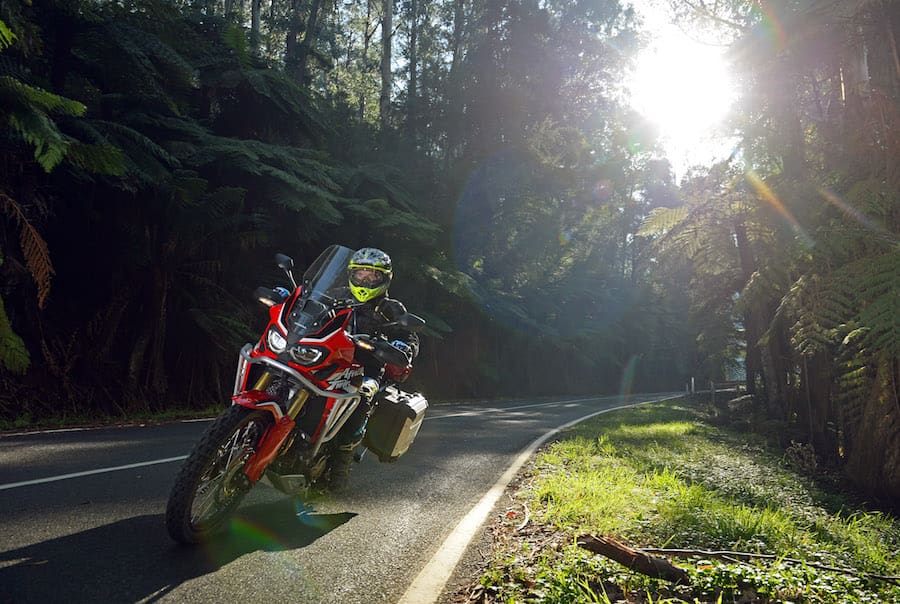
Dual-Clutch Transmission (DCT)
Honda has released two versions of the Africa Twin, one with dual-clutch transmission and one without (see New Tech on p22). We were pooh-poohed on social media for testing the DCT model, and for me this was confirmation the right choice had been made. I wanted to try what most riders would instinctively avoid. And I was particularly keen to see how it performed off-road.
Somewhat prophetically, a guy interested in the Africa Twin approached me near the start of my ride. His elderly brother in the UK has the DCT equipped VFR1200, and loves it. His hands, which have probably shovelled coal and hammered nails for not far short of a century, are riddled with old- people ailments, and too knackered for pulling clutches in and out all day.
This got me thinking: ‘Who exactly is DCT for?’ The answer is, DCT is for many different folks: left leg amputees, limp left wristers, plain lazy bastards, technophiles, gearophobes, your momma, and maybe even at some point in time, for me. That’s who. And many more besides. The point is, it’s not a revolution, it’s not an abomination, and it’s not necessarily the future, it’s just a motorcycle with more choices for you and me to accept or reject.
So does it work? Too bloody right it does. Brilliantly in fact. Would I buy one over the manual model? Nope, I’d spend the extra cash fitting out the bargain base model with all the fruit it needs to tackle seriously rough terrain and go longer distances between drinks. If my left ankle was fused together due to one of my many stupid crashes, that choice may be different.
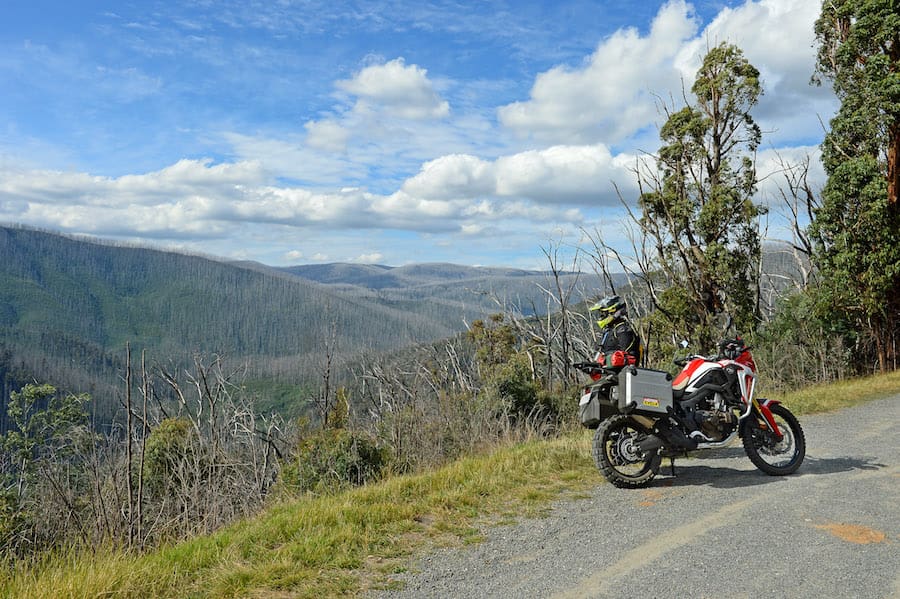
There are two important things to know about the DCT bike. Firstly, this version can also be ridden just like a manual bike with an automatic clutch, similar to the Rekluse clutches which are now a popular mod with enduro riders. So it’s not a case of choosing between an automatic or manual model, because with DCT you get a version of both.
The second thing to know is that you won’t miss having a manual clutch until you are at walking speed. If you intend to do a lot of slow technical off- road riding, this is absolutely where you’ll miss it the most. In fact the DCT bike is less adept at any type of slow-speed manoeuvring, whether off- or on-road.
Selecting the G mode adjusts the operation of the DCT to suit steep technical terrain – detecting the incline and either controlling your rate of descent via engine braking or keeping the engine powering uphill. It also reduces the amount of clutch slip between gear changes. This snappier gear selection gives the bike faster acceleration, and for me feels smoother and far more natural.

Even in the lower 850mm seating position, I only make ground contact with the tips of my toes on both sides (inside leg 76cm, thanks for asking). And as with all big adventure bikes, this makes the low-speed manoeuvring style known as ‘paddling’ feel just as awkward and comical as it looks – even more so without the aid of a manual clutch to micro-manage power to the rear wheel. To compensate, at slow speed I preferred to use the Toni Bou technique (I bloody wish!): stood up on the pegs ‘trials style’, carefully balancing the throttle and rear brake. With both feet down for security, balancing the throttle and front brake is the only option, but not quite so elegant.
Because DCT returns to neutral when the engine is killed, the Africa Twin has a park brake, operated by a lever where the clutch lever would normally be. To prevent the rider from absent-mindedly grabbing a handful of rear brake, the lever blade is so far away from the bar that only a fully grown mountain gorilla could possibly reach it with the tip of his middle finger. What I found curious about this arrangement is that a cable-operated caliper is used, positioned under the swingarm opposite to the bike’s regular foot-operated hydraulic brake caliper. I can only assume this is a cheaper option than a system which uses the bike’s primary braking system, in the way some hill-hold park brakes work. However, it also constitutes extra unwanted unsprung weight. I’d have liked the option to use the hand rear brake in certain technical off-road situations, like some riders are fitting to enduro bikes, but I doubt the caliper would cope well since it wasn’t intended for that kind of sustained abuse.

MANUAL
Comparing the manual and DCT bikes back to back confirmed my initial thoughts. Having a clutch lever in your left hand gives you the ability to feed power to the ground 0.1kW at a time, and chop it in an instant. DCT will have to come a long way to match this level of slow- speed control. But the 14kg difference in weight between the DCT Africa Twin and the manual gearbox, non-ABS model is the real deal breaker for me. The extra heft inhibits the DCT bike’s off-road handling, and makes it a daunting prospect to pick up off the ground when the inevitable happens. The manual Africa Twin, on the other hand, is just on the right side of how light and managable a production 1000cc dirtbike can be, with plenty of potential to be even more trim and focused with a touch of tinkering. I can’t wait to see what some owners will do with True Adventure in their mind and the standard Africa Twin as the starting point.
CHASSIS
For tarmac touring and taking most gravel detours, the Africa Twin’s Showa suspension soaks up the bumps with luxuriant plushness. However, as capable and enjoyable as it is to ride on the tarmac, it’s certainly no sportsbike on the black top. Fork dive under heavy- braking is considerable – a normal characteristic of conventional long travel suspension. The Africa Twin’s more expensive competitors now use semi-active electronic suspension systems to eliminate excessive weight transfer, but this adds both cost and weight.
For rough off-road and fully loaded use, I felt the Africa Twin’s suspension would benefit from some extra spring support, even for my rakish 68kg. Admittedly, I probably worked the bike’s suspension harder than it will be in regular duty. But there are also plenty of owners who will want to go big, or who are big themselves. They are sure to find the limits as I did.
Bottoming out the suspension proved easy on the more extreme off-road tracks, and damping performance faded slightly once the units were hot.
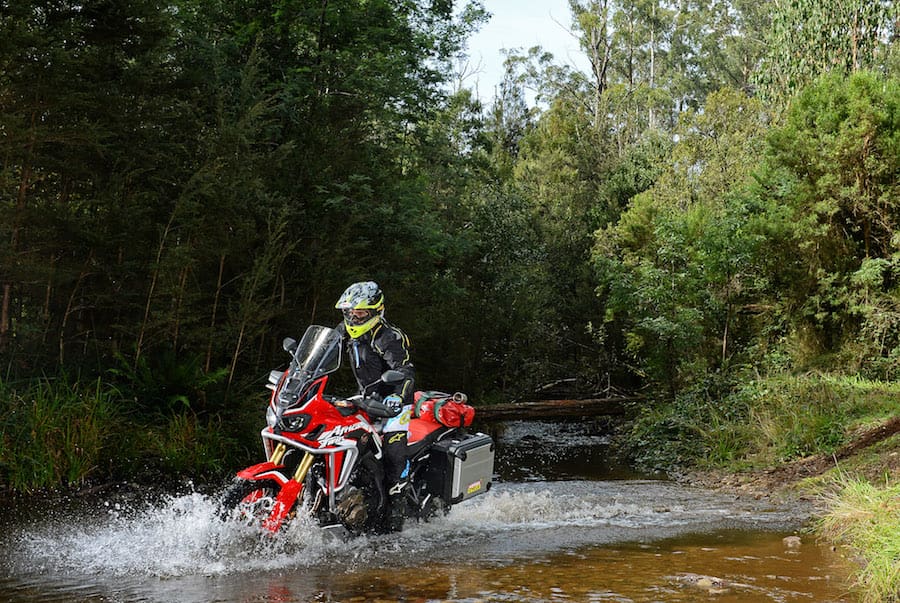
I guess 90 per cent of Africa Twin owners will wonder what the hell I’m on about; the other 10 per cent will still love their new Honda, but perhaps even more so after a suspension tune up to suit their weight and aggression, and intended terrain.
Although the front brake lever feels spongy, the Africa Twin has ample stopping power, with a level of control and feel that excels in loose off- road conditions. The front ABS works brilliantly off-road – a relief since it’s a non-switchable single- level system. Switching the ABS to off-road mode deactivates the rear ABS only. This combination gives plenty of feel and progression at the rear brake lever for greater off-road control. Top marks here. Ground clearance is a respectable 250mm, but the aluminium sump guard is still essential for off-road antics. Even if you don’t smack it down on terra firma, there’s always the chance of a flying rock puncturing the crankcases. I expect many adventurers will feel the need to fit something fuller, to further protect the low slung exhaust headers and wrap up around the engine side covers.
Standing up for off-road sections I found the pegs-to-bar distance quite close compared to other big adventure bikes, and more akin to an enduro bike’s cockpit dimensions. This will suit regular trail riders, and will simply require some adapting for those coming from another maxi-adventure-tourer.
The grippy serrated off-road style pegs have removable rubbers, but the metal platform is very small in terms of modern off-road standards.
While a generously wide range of steering lock is often a good thing for manoeuvrability, in the case of the heavily weighted front end of the DCT model Africa Twin, there is too much steering angle. As you turn the handlebar to make a tight turn there comes a point in the steering axis where the front end pulls forcefully toward full steering lock. I found the best way to counter this was to anticipate this point and physically resist the bars from flopping to the side. Once at full lock the bike tends to shovel the front tyre rather than turn anyway, so I’d be tempted to modify the steering stops and reduce the lock slightly. This would also help when performing spin turns on dirt to get out of tight spots.
A quick check of the DCT-equipped bike with a digital angle guage confirmed the source of this steering sensation, a comparitively shallow head angle of 28o, which will increase further with rider and luggage. A shallow rake and/or a large fork offset requires you to lift the bike’s weight further as the bars are swept from full lock to straight ahead. Conversely, it also causes the bike’s weight to pull the steering towards full lock when the bars are turned. The shallower the rake, greater the fork off- set, and heavier the bike, the greater the ‘flop’ effect. While I’m moaning about the finer details, the accessory centrestand is too high with a pivot too rearward. Other packaging considerations possibly forced the designers’ hand here, but the result is a stand which is a pig to swing the bike up onto, particularly when fully loaded.
It’s the small details which can make a bike your best friend, or just your current ride. They matter.
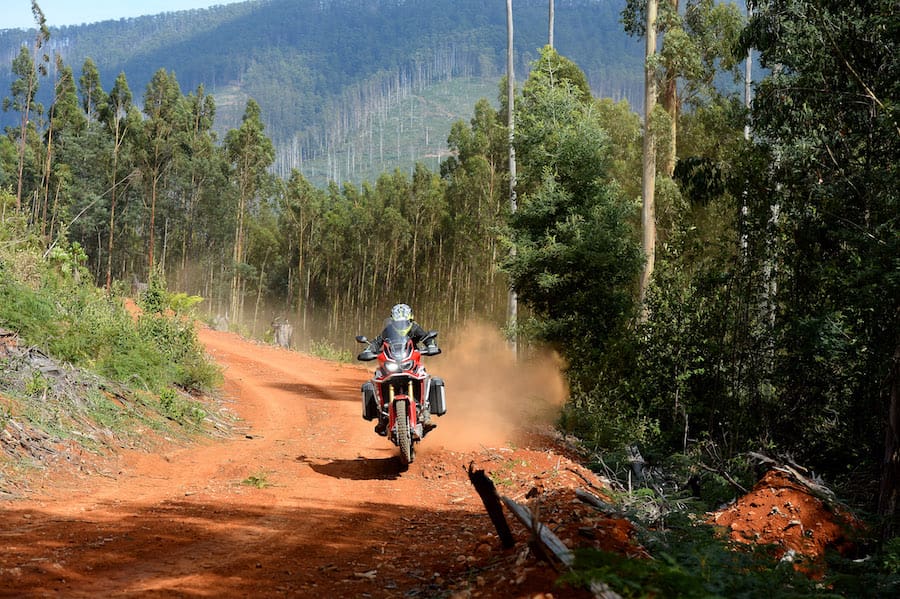
ENGINE
Although the Africa Twin gives up 200cc to its main class rivals, there wasn’t a situation where I found the Honda’s 270o 1000cc parallel twin under-gunned. Relatively soft low-rpm torque is followed by a distinct kilowatt kick at 6000rpm, and it’s at this engine speed where the Honda really lights up and sparkles. I don’t expect owners to be left particularly wanting or disappointed – power is only a small part of the satisfaction and capability equation – even if comparatively speaking there are far bigger hitters in this weight category. Bang-for-buck, the standard Africa Twin has them all beaten.
Honda’s ‘torque control’ system is a traction control system by any other name, and works in the same way. TC level three should be kept strictly for riding wet tarmac on knobblies, because using it off- road is just a good way to get nowhere, as you spend more time waiting for the motor to stop spluttering than you do going forward. Levels two and one are more useful as they reinstate power far sooner. Where TC was most effective was controlling the DCT bike’s initial, ‘un-clutchable’, throttle response in super-slippery off-road conditions like wet clay.
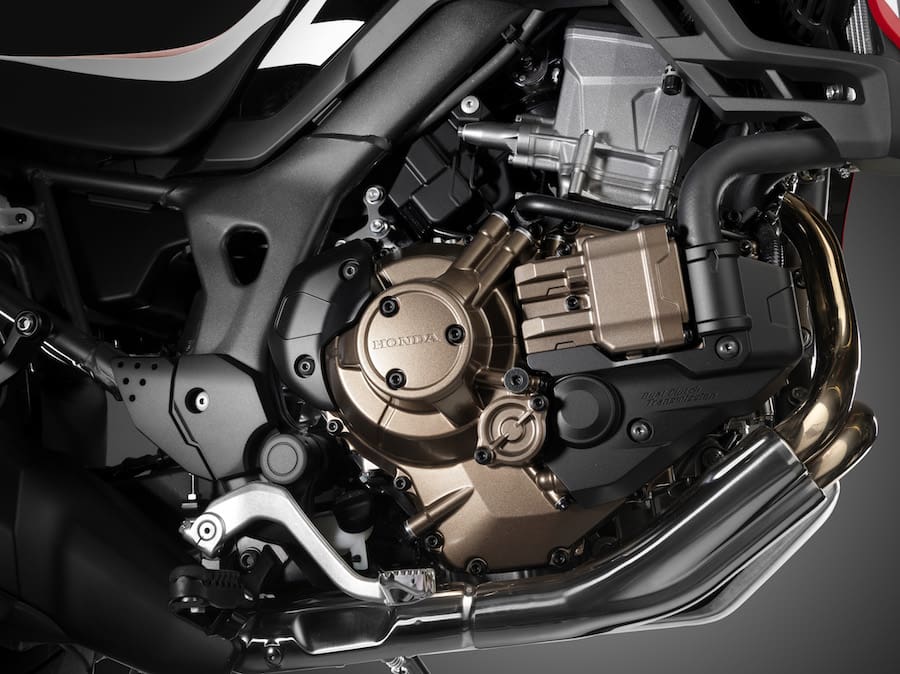
Resetting the TC, ABS and DCT modes every time you stop and turn off the ignition quickly becomes a chore, even though the process isn’t a terribly difficult or time consuming one. Why can’t they just assume we’re not idiots who forget where we left it?
As with any large capacity adventure bike, the Africa Twin is a physically imposing heavyweight when ridden in the dirt, and its off-road capability is determined predominantly by the confidence, skills and strength of the rider. Anyone lacking in these areas who dreams of tackling seriously spirit- sapping terrain on a Honda, frankly, should buy a CRF250 or 450X. But of course that goes for all of the Africa Twin’s hefty competitors, too.
If it seems I’ve been a little critical of the Africa Twin, well tough, that’s my job. The fact is I loved the bike, and despite its few shortcomings, I couldn’t justify spending my own money on any other litre- plus adventure bike while Honda can offer the base model Africa Twin for such a great price. Sure, I’d end up spending more to get it set up to my taste and adventurous ambitions, but I reckon I’d still be up on the deal. If I had money to burn, my choices might be different. But then again, probably not.
